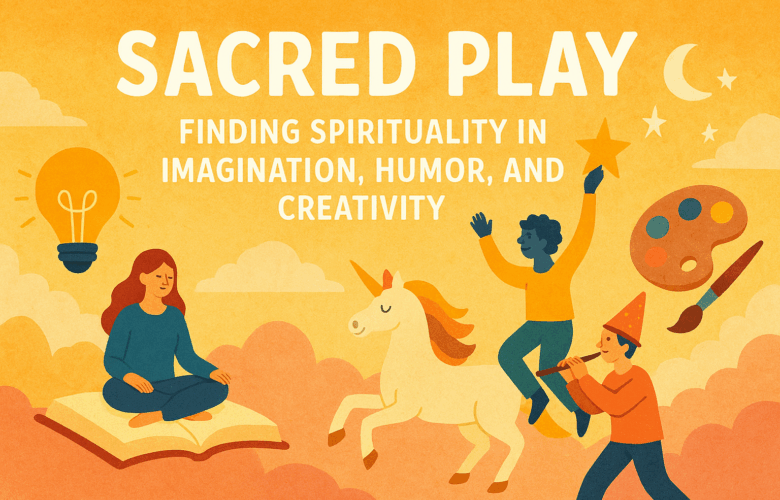When most people hear the word spirituality, they immediately picture something supernatural: gods, angels, disembodied souls, or mysterious energies flowing beyond the reach of science. But what if spirituality doesn’t have to mean any of that? What if, at its heart, spirituality is simply the human capacity to view life in a deeper, more colorful, more meaningful way?
That’s where imagination, humor, and creativity step in. These aren’t escapes from reality—they are ways of experiencing reality with more texture and more humanity. They allow us to take what is natural, psychological, and relational and reframe it in a fantastical light. They are the bridges that let us treat life as a story, a song, or even a cosmic joke that we’re all in on together.
Redefining Spirituality
For the purposes of Sacred Play, let’s define spirituality not as a supernatural realm, but as:
“The imaginative inner representation of what is natural and psychological, expressed in ways that bring awe, meaning, and connection.”
Spirituality in this sense isn’t about proving invisible forces. It’s about cultivating the ability to step back from life’s raw data and see the poetry behind it. A sunrise isn’t just photons striking our eyes—it’s a painting splashed across the sky, reminding us of endings and beginnings. Laughter isn’t just a spasm of the diaphragm—it’s the music of shared absurdity, a sacred chorus that says: we survived another day together.
Spirituality, when seen this way, becomes available to everyone, regardless of belief. You don’t need to pray to an invisible deity—you can light a candle, tell a story, or sing a silly song, and find yourself lifted into something beyond the ordinary grind.
The Sacred Role of Imagination
Imagination is the birthplace of meaning. It’s how we turn fleeting experiences into narratives that stick with us, how we weave metaphors to make sense of what we feel inside.
- Myth and fantasy: Dragons may not exist, but the idea of dragons gives us a way to explore courage, greed, fear, and triumph.
- Playfulness: A child who makes a cardboard box into a rocket ship isn’t deceiving themselves—they’re practicing a spiritual act of re-visioning the world into something alive with adventure.
- Art and creativity: A painting doesn’t just replicate a scene—it invites us into the inner landscape of the artist, turning private imagination into shared revelation.
In all of these, imagination becomes a sacred practice—not because it’s otherworldly, but because it deepens the way we experience this world.
Humor as a Spiritual Lens
If imagination paints life with wonder, humor frames it with humility. Humor is the reminder that none of us truly has control, that life is ridiculous, messy, and impossible to script perfectly.
Think of the way laughter breaks tension in a heavy moment. Or how satire flips power structures upside down and exposes their cracks. Or how even in grief, a shared chuckle can soften the sharpest edges of pain.
Humor is spiritual because it reconnects us to each other and takes the sting out of fear. It says: Yes, this is overwhelming, but we’re in it together, and if we can laugh, we can breathe.
Creativity: The Everyday Sacrament
Creativity is where imagination and humor meet practice. It’s when ideas and play become embodied in something tangible: a poem, a melody, a sculpture, a dance, even a joke told at just the right moment.
Creativity is sacramental in the sense that it takes the invisible—emotions, insights, whims—and makes them visible. It externalizes what’s inside, giving it form and inviting others to share in it.
In this way, creativity doesn’t just make art. It makes community. It’s how we say: Here, I felt this. Do you feel it too? And when someone nods, laughs, or weeps with us, spirituality is happening.
Spirituality Without Superstition
One of the most freeing aspects of this reimagined spirituality is that it doesn’t require belief in invisible forces. You can find transcendence in a joke, a painting, a song, or a quiet walk where you let your mind play with the shapes of clouds.
This isn’t a dismissal of religion, but a recognition that the gifts often attributed to gods—wonder, connection, meaning—are actually rooted in human imagination and creativity. They live in us, and they’re expressed best when we dare to play.
Practicing Sacred Play
So how do we embody this kind of spirituality? Not with rituals of obligation, but with acts of imaginative play:
- Write a story that exaggerates your fears until they look silly.
- Make up a holiday just because your cat did something funny.
- Create a piece of art that captures your inner world, even if nobody else “gets it.”
- Tell a joke at your own expense and let yourself be part of the cosmic comedy.
- Spend a moment seeing the ordinary as enchanted—your morning coffee as a potion, your kitchen as a cathedral, your laughter as a hymn.
These playful acts are not trivial. They’re how we practice reverence for life without getting weighed down by solemnity.
Closing: The Sacred in the Silly
Spirituality doesn’t have to be solemn or supernatural. It can be silly, playful, irreverent, and deeply human. When we allow imagination, humor, and creativity to shape the way we experience reality, we open ourselves to awe that is grounded, not in myths of the unseen, but in the astonishing richness of what is already here.
In the end, Sacred Play is about living life as though it’s more than survival. It’s about treating joy, laughter, and creativity as holy—not because they descend from above, but because they rise from within us, binding us together in the beautiful, ridiculous, ever-unfolding adventure of being human.


